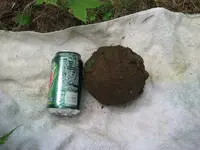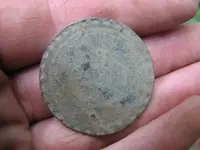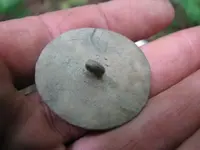VERMONTPACKRAT
Bronze Member
- Joined
- Aug 6, 2007
- Messages
- 2,243
- Reaction score
- 391
- Golden Thread
- 0
- Location
- Topsham, Vermont
- Detector(s) used
- Minelab 705, Garrett ace 250
This 20lb ball of iron was found by a friend of mine that I recently talked into buing an ACE 250. His very first target dug today!
Is it a cannon ball? Appears to be solid.... I have not cleaned it in anyway so far. Feedback is much needed.
The button was found by me at the same spot. Not sure if much info is available here other than its old....
Here are some pics. VPR

Is it a cannon ball? Appears to be solid.... I have not cleaned it in anyway so far. Feedback is much needed.
The button was found by me at the same spot. Not sure if much info is available here other than its old....
Here are some pics. VPR
Attachments
Upvote
0






 Don't worry, jimbob, I found the humor here.
Don't worry, jimbob, I found the humor here. 

 What I should have said, is that they (12 Pounders) weren't used frequently and even to a much lesser degree for general land engagements, before the Civil War . We know that they were used in the Revolutionary and all the European Wars but 12 pound balls of that type are abit smaller than the types that were used for those purposes. However, when we look at the American Civil War, in the first couple years of the war they used alot of 6 pounders but quickly found that they were inadequate in both range and damage caused. By the middle of the war, you rarely saw 6 pounders except some on the Southern side and saw a exponential increase in the use of the 12 pounder. The 12 pound case and solid shot became the workhorse of artillery for the cannon and howitzer and the standard, used during this struggle...along with Parrotts, Whitworths, Dyers, and a few other lessers.
What I should have said, is that they (12 Pounders) weren't used frequently and even to a much lesser degree for general land engagements, before the Civil War . We know that they were used in the Revolutionary and all the European Wars but 12 pound balls of that type are abit smaller than the types that were used for those purposes. However, when we look at the American Civil War, in the first couple years of the war they used alot of 6 pounders but quickly found that they were inadequate in both range and damage caused. By the middle of the war, you rarely saw 6 pounders except some on the Southern side and saw a exponential increase in the use of the 12 pounder. The 12 pound case and solid shot became the workhorse of artillery for the cannon and howitzer and the standard, used during this struggle...along with Parrotts, Whitworths, Dyers, and a few other lessers. Where he found it
Where he found it 
